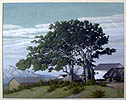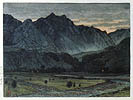|
No artist is able to savor the satisfaction I have when [the printer] is able to bring out just the color I was looking for. -- Kawase Hasui, 1935 The shin hanga tradition was a collaborative effort and Hasui's role as artist was to create the preliminary design. He then worked with the carver and printer to transform this design into a woodblock print. Hasui's prints were originally conceived as rough sketches in his notebook. He travelled frequently and made numerous sketches while on location. These sketches were later refined into more finished pencil drawings and into watercolors. Describing his role, Hasui wrote: |
| The carver had the difficult task of translating the original watercolor into a set of cherry wood blocks. Hasui's prints lack some of the detail and shading found in his watercolors, perhaps because the carver needed to simplify the design. To reproduce the brush strokes and layered look of a watercolor would involve carving innumerable color blocks. And besides, shin hanga were not meant to be merely reproductions of watercolors. Part of the beauty of woodblock prints is in their clean lines and flat expanses of color, the very qualities that the carver helped create. Figure 1 shows the simplification in detail from a Hasui watercolor to the corresponding print.
| ||||
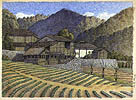 watercolor ca. 1941, 15" x 20" |
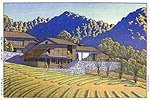 woodblock print 1941, 9.5" x 14.5" | Hasui used impressionistic layered brush strokes in the watercolor, giving a sense of depth to the mountains and sky. The carver eliminated much of this detail, resulting in a more highly stylized and simple design. | ||
The printer was responsible for choosing the colors and printing the blocks, though he worked closely with Hasui and the publisher Watanabe. The color differences between Hasui's watercolors and woodblock prints can range from slight changes to major overhauls in palette. Hasui used darker, grayer tones in many of his watercolors, reflecting a more realistic (and some have called "morose") view of the world. His woodblock prints are almost always brighter in color, sometimes to the point of being surreal. Brightening the colors was probably Watanabe's decision, based on what most appealed to his customers. Figures 2 and 3 illustrate typical changes in palette from watercolor to woodblock print.
| ||||
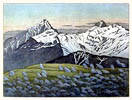 watercolor ca. Sept. 1949, 15" x 20" |
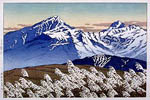 woodblock print 1950, 9.5" x 14.5" | The surreal blue used in the woodblock print greatly enhances this design, giving a sense of the mountains' coldness and majestic height. | ||
| ||||
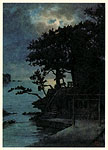 watercolor ca. 1937, 10.5" x 14.5" |
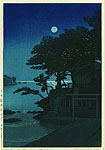 woodblock print June 1937, 10" x 15" |
The woodblock print has a much cleaner look than the original watercolor. The deep blue expanse of sky makes a better contrast to the dark detailed temple and trees. Many of Hasui's night scenes were printed in these rich blue tones, a palette which continues to appeal to collectors. | ||
|
The printer often experimented with different colors before settling on a version which was acceptable to Hasui and the publisher. Some of these trial prints still exist today, and they give an idea of the color variations that were considered. Though one might expect an artist like Hasui to be interested in experimentation, he seemed to view it as inefficient, writing:
|
| |||||||
 watercolor ca. 1923 |
 trial print ca. 1923 |
 trial print ca. 1923 |
 trial print ca. 1923 |
 trial print ca. 1923 |
 final print 1923 | ||
|
In a few cases, the final print seems like a total reworking of the original watercolor. Narazaki, the author of the Hasui Mokuhangashu, would have us believe that such changes were made purely for artistic reasons. He wrote:
| ||||
 watercolor ca. 1930 |
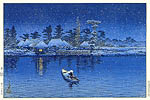 woodblock print 1930, 9.5" x 14.5" | The watercolor and print depict essentially the same scene, but during different seasons. The palette and many of the details have been reworked in the print. | ||
| According to Pachter, Hasui was essentially a freelance artist. Most of his 600+ designs were published by Watanabe, but he was never considered an employee of the Watanabe Color Print Company. He was only paid for the sketches that were used to create woodblock prints. It seems that Hasui was allowed to keep most of the watercolors used as print designs. He was not well-paid and he sold his watercolors for additional income. Many of Hasui's watercolors do not have related woodblock prints. They may have been rejected as print designs, or they may have been created specifically for resale. Figure 6 shows several Hasui watercolors that apparently do not have corresponding woodblock prints. |
|
Most of the Hasui watercolors found in museums and auctions date from the 1930's through the 1950's. Hasui did create watercolors in earlier years, but few of them have survived. It is important to note that his watercolors usually do not have dates written on them. If there is a corresponding print, an approximate date might be established for the watercolor. However, there are sometimes doubts as to the true date of a watercolor.
There is always the possibility that Hasui created watercolors based on older print designs in order to sell them to collectors. Certainly there may have been financial motivations for doing so. Figure 7 shows a watercolor which appears to be the basis for a 1925 woodblock print. It was purchased alongside later post-WWII watercolors, so there have been questions about when it was actually painted. |
| ||||
 watercolor no date, 10" x 19.5" |
The format of this watercolor suggests that it was indeed the basis for the 1925 print. Hasui designed many long format prints at the beginning of his career, before switching to a primarily oban format. (see Figure 4) Because of its long format, this watercolor has a lot of additional detail that the print lacks. If the watercolor was only done as a later copy, why not copy the print exactly? Adding that detail at a later date would have been difficult.
There are also faint pencil marks at the top of the mountains, where Hasui originally drew the mountaintop before moving it slightly. This further suggests (to us less cynical collectors) that this watercolor was a working sketch, perhaps even drawn on location. | |||
| We cannot rule out the possibility that Hasui copied earlier designs in later watercolors, but there is no evidence to support this. In fact, we don't even know if Hasui had access to his early woodblock prints. Some collectors therefore find it reasonable to assume that all Hasui watercolors are unique and predate their corresponding woodblock prints. | ||
| So, if you're lucky enough to come across a Hasui watercolor, how do you identify it as such? One obvious thing to look for is the red Hasui seal. Almost all of Hasui's watercolors have the square seal and signature pictured in Figure 8. The seal measures approximately 13 mm in width and height. The square seal also comes in another variation seen in Figure 1. Unfortunately, the author was unable to obtain an accurate scan of this variation. The rest of Hasui's watercolors are unsigned, as in Figure 11, or have the round Hasui print seal, as in Figure 3. There are also visual differences between Hasui watercolors and woodblock prints. A woodblock print has crisp lines and smooth areas of color, while a watercolor has brush strokes and layered colors. Watercolors were made on slightly thicker paper than woodblock prints, and they often have larger margins than prints. There is very little color bleed-through on the back of watercolors because the ink was painted on the surface, not pressed into the paper by a baren. Below are additional comparisons of Hasui watercolors and the corresponding woodblock prints. | Figure 8 watercolor seal | |
| ||||
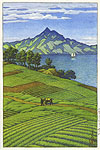 watercolor ca. 1937 |
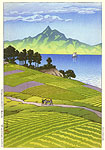 woodblock print 1937, 10" x 15" |
Hasui designed stage sets as a young man and this experience was often reflected in his prints. The main difference between this watercolor and print is in the treatment of the mountain. In the watercolor, the mountain casts shadows and reflections, giving it dimension and depth. However, in the print, the mountain is flat like a stage backdrop. The flatness is emphasized by the color gradient and strong horizontal water line. | ||
| ||||
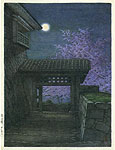 watercolor ca. 1953 |
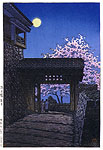 woodblock print 1953, 9.5" x 14.5" |
This comparison illustrates some of the limitations of the woodblock medium. The cherry tree, in particular, suffers in the translation. In the watercolor, it is sensitively rendered in a delicate bluish-pink. The moonlit blossoms seem light and airy, giving dimension to the tree. In the woodblock print, the cherry blossoms are more brightly colored and heavily outlined. The tree is flat in comparison. Also absent in the woodblock print are the realistic shadows cast by the gateway and the balcony. The addition of the two figures does add minor visual interest and a sense of scale to the woodblock print. | ||
| ||||
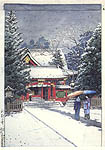 watercolor ca. 1930 |
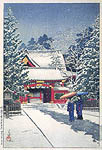 woodblock print New Years Day 1931 9.5" x 14.5" | This watercolor is interesting because it shows changes that were made to the final design. The path was moved slightly to the left and there are pencil lines in the watercolor indicating this change. The more central placement of the path helps to draw the viewer into the print. | ||
| ||||
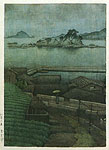 watercolor ca. 1950 |
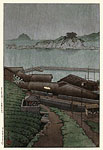 woodblock print 1950, 9.5" x 14.5" | The mood of the watercolor is much heavier than the print, because of the dark, layered colors. Though the overall composition remains the same, the stance of the figure was changed slightly in the print. The bright yellow umbrella also stands out. These minor changes make the print seem less oppressive, though it is still a dark image. | ||
| ||||
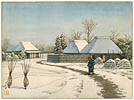 watercolor ca. 1946, 12" x 16" |
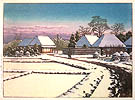 woodblock print 1946, 9.5" x 14.5" | The watercolor has a peaceful, luminous quality that does not translate into the hard-edged print. In addition to the jarring color change, the composition of the print was altered slightly. The woman and baby, the focal point of the watercolor, were placed farther away in the print. They blend into the background, leaving the foreground empty and uninteresting. | ||
| ||||
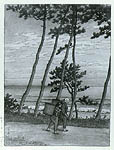 watercolor (b/w photo) ca. 1954 |
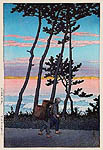 woodblock print 1954, 9.5" x 14.5" | It would be interesting to see the palette differences, but the author was unable to obtain a color photo of the watercolor. In fact, it is difficult to do more than a surface comparison with only a black and white photo. This shows how important color is in establishing mood. The print is very similar in composition to the watercolor, and it seems to capture the same feeling. | ||
| These comparisons demonstrate the challenges involved in translating a delicate watercolor into a woodblock print. Clearly the artisans who created these prints were remarkably skilled, as most of the prints turned out very similar to Hasui's original designs. Yet there was an element of unpredictability in this process. Hasui recognized this, writing:
Author's note: This article contains many statements which are based on observation and personal opinion. Art is a subjective, individual experience, and one person cannot hope to illuminate every detail of these comparisons. Undoubtedly, some collectors will feel differently about the some of the above watercolors and prints. The input and opinions of others on this subject are welcome. -- Robin Devereux, March 2000 Editor's note: Hasui was understood to have produced and sold watercolor paintings to supplement his income later in his career. So far there are no definitive, widely accepted guidelines to distinguish an original watercolor "study" from one or more later versions, although some collectors (and this article's author) do not rule out a 'finished' format with square seal as indicating a later painting. A smaller number of rougher watercolors exist with round Sui seals and Western-style dates in the image; these could possibly be the studies on which the prints were based. -- April 2001
| |
| Bibliography | |
|
Brown, Kendall and Hollis Goodall-Cristante. Shin-Hanga: New prints in modern Japan. Los Angeles County Museum of Art, 1996. 119 pp.
Edo-Tokyo Museum, Tokyo in transition - The changing city as depicted in modern woodblock prints. Tokyo, 1996. 247 pp. Mitsuba Museum of Showa Women University, Exhibition of prints by Kawase Hasui, a landscape printmaker loved by the world. Tokyo, 1997. 44 pp. Pachter, Irwin J. Kawase Hasui and his Contemporaries: The Shin Hanga (New Print) Movement in Landscape Art. Everson Museum of Art, Syracuse, New York, 1986. Sotheby's. Japanese Works of Art. Sale 7183, Sept. 18, 1998; Lots 305-624 Stephens, Amy Reigle (ed). The new wave: Twentieth-century Japanese prints from the Robert O. Muller Collection. London, 1992. 228 pp. | |
| Watercolor Sources | |
|
Figure 1: Higashi Agano, Saitama Mitsuba Museum catalogue, plate 75
Figure 2: Urabandai
Figure 3: Benten Shrine, Kakizaki, Shimoda
Figure 4: Ioridani Mountain Pass
Figure 5: Ushibori
Figure 6a: Rain at Senami
Figure 6b: Japanese Farmhouse
Figure 6c: Junigahara
Figure 6d: Rain at Red Temple
Figure 6e: Mountains and River
Figure 7: Nezame Gorge
Figure 9: Mt. Unsendake from Amakusa
Figure 10: Full Moon at Matsuyama Castle
Figure 11: Snow at Hiejinja Shrine
Figure 12: Rain at Mirotsu, Wakayama
Figure 13: After Snow at Sekiyado
Figure 14: Evening at Mokko | |

